The Intel 9th Gen Review: Core i9-9900K, Core i7-9700K and Core i5-9600K Tested
by Ian Cutress on October 19, 2018 9:00 AM EST- Posted in
- CPUs
- Intel
- Coffee Lake
- 14++
- Core 9th Gen
- Core-S
- i9-9900K
- i7-9700K
- i5-9600K
Gaming: Ashes Classic (DX12)
Seen as the holy child of DirectX12, Ashes of the Singularity (AoTS, or just Ashes) has been the first title to actively go explore as many of the DirectX12 features as it possibly can. Stardock, the developer behind the Nitrous engine which powers the game, has ensured that the real-time strategy title takes advantage of multiple cores and multiple graphics cards, in as many configurations as possible.
As a real-time strategy title, Ashes is all about responsiveness during both wide open shots but also concentrated battles. With DirectX12 at the helm, the ability to implement more draw calls per second allows the engine to work with substantial unit depth and effects that other RTS titles had to rely on combined draw calls to achieve, making some combined unit structures ultimately very rigid.
Stardock clearly understand the importance of an in-game benchmark, ensuring that such a tool was available and capable from day one, especially with all the additional DX12 features used and being able to characterize how they affected the title for the developer was important. The in-game benchmark performs a four minute fixed seed battle environment with a variety of shots, and outputs a vast amount of data to analyze.
For our benchmark, we run Ashes Classic: an older version of the game before the Escalation update. The reason for this is that this is easier to automate, without a splash screen, but still has a strong visual fidelity to test.
| AnandTech CPU Gaming 2019 Game List | ||||||||
| Game | Genre | Release Date | API | IGP | Low | Med | High | |
| Ashes: Classic | RTS | Mar 2016 |
DX12 | 720p Standard |
1080p Standard |
1440p Standard |
4K Standard |
|
Ashes has dropdown options for MSAA, Light Quality, Object Quality, Shading Samples, Shadow Quality, Textures, and separate options for the terrain. There are several presents, from Very Low to Extreme: we run our benchmarks at the above settings, and take the frame-time output for our average and percentile numbers.
All of our benchmark results can also be found in our benchmark engine, Bench.
| Ashes Classic | IGP | Low | Medium | High |
| Average FPS | 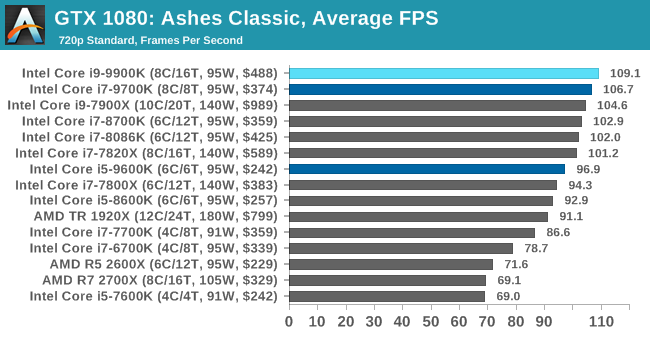 |
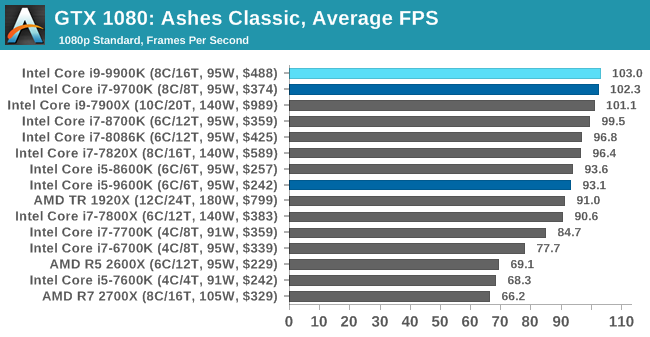 |
 |
 |
| 95th Percentile | 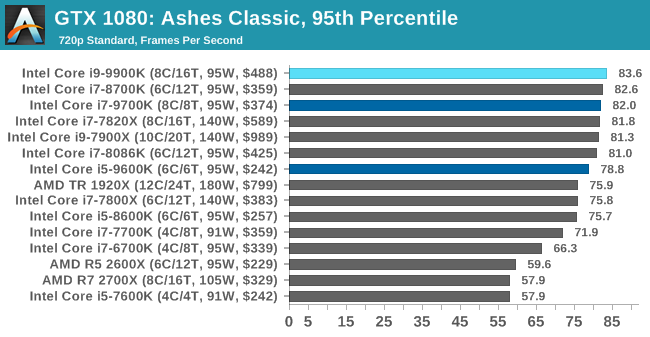 |
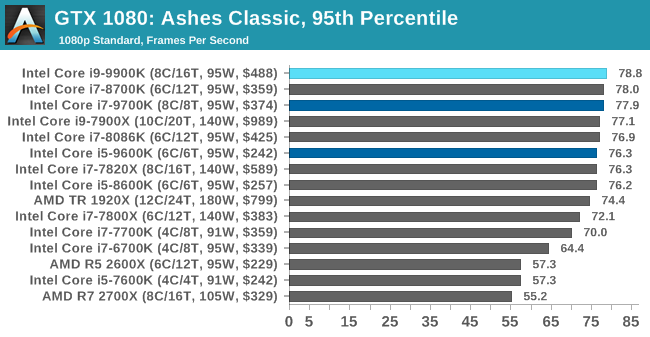 |
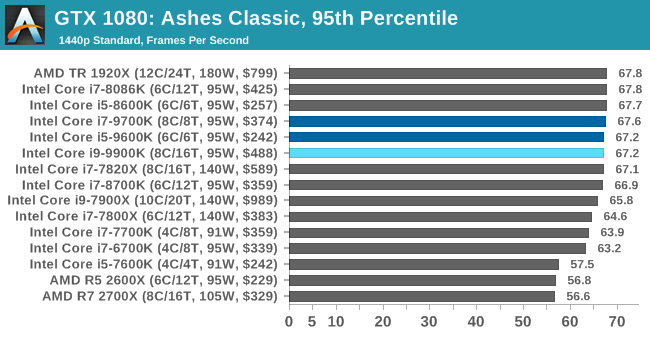 |
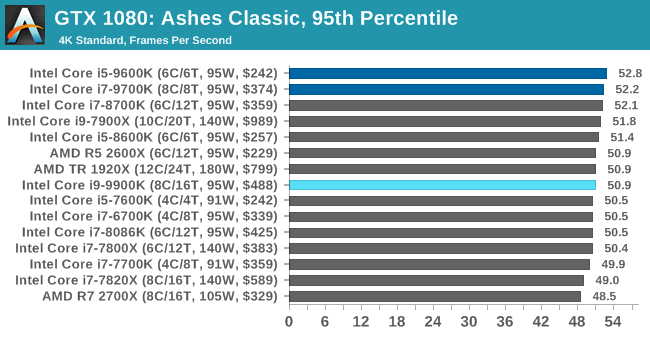 |
As a game that was designed from the get-go to punish CPUs and showcase the benefits of DirectX 12-style APIs, Ashes is one of our more CPU-sensitive tests. Above 1080p results still start running together due to GPU limits, but at or below that, we get some useful separation. In which case what we see is that the 9900K ekes out a small advantage, putting it in the lead and with the 9700K right behind it.
Notably, the game doesn’t scale much from 1080p down to 720p. Which leads me to suspect that we’re looking at a relatively pure CPU bottleneck, a rarity in modern games. In which case it’s both good and bad for Intel’s latest CPU; it’s definitely the fastest thing here, but it doesn’t do much to separate itself from the likes of the 8700K, holding just a 4% advantage at 1080p. This being despite its frequency and core count advantage. So assuming this is not in fact a GPU limit, then it means we may be encroaching on another bottleneck (memory bandwidth?), or maybe the practical frequency gains on the 9900K just aren’t all that much here.
But if nothing else, the 9900K and even the 9700K do make a case for themselves here versus the 9600K. Whether it’s the core or the clockspeeds, there’s a 10% advantage for the faster processors at 1080p.


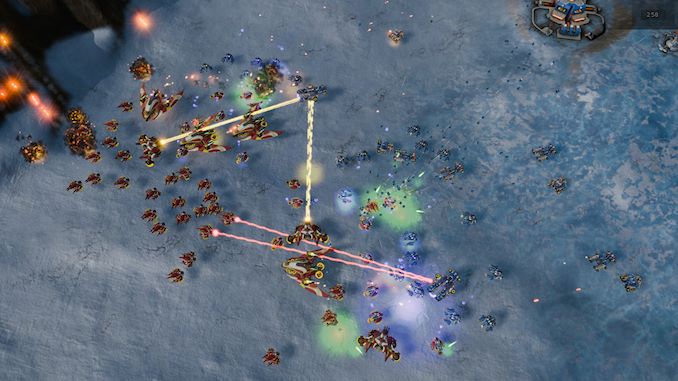









274 Comments
View All Comments
DominionSeraph - Sunday, October 21, 2018 - link
The 8700k is also pulling 150W while the 8086k is 95W. Something's not right there._mat - Wednesday, November 7, 2018 - link
There can be two reasons why that is the case:1) The mainboard settings for Power Limits were different.
2) The 8086K ran into Power Limit 1 while the 8700K was not.
Whatever is the case here, it is no doubt that the 8086K did run into Power Limit 1 after the "Time Above PL1" (= power budget) was depleted. The 95 Watts are exactly the specified TDP of the CPU and Intel recommends this as Power Limit 1 value.
So the problem here is that the Power Limits and Current Limits of the mainboard are not properly documented and seem to differ between the test candidates. While the 8086K obviously had Power Limits in place, the 9th gen CPUs were benched with no limits at all (only temperature limit at 100 °C on a core).
Also, the whole page on power consumption needs rework. The TDP does matter depending on the board and its default settings.
ballsystemlord - Sunday, October 21, 2018 - link
Ian! Many of your tests ( Y-Cruncher multithreaded, apptimer, FCAT - ROTR, WinRAR ), are taking too short of a time. You need some differentiation here! Please make them harder.R0H1T - Sunday, October 21, 2018 - link
>In case the previous comment was missed.I see that the last few pages have included a note about Z390 used because the Z370 board was over-volting the chip? Yet on the Overclocking page we see the Z370 listed with max CPU package power at 168 Watts? Could you list the (default) auto voltage applied by the Asrock Z370 & if appropriate update the charts on OCing page with the Z390 as well?
mapesdhs - Sunday, October 21, 2018 - link
"Intel has promised that its 10nm manufacturing process will ramp through 2019, ..."Ian, what promises did Intel make 2 years ago about what they would be supplying now?
eastcoast_pete - Sunday, October 21, 2018 - link
My guess is that Intel is now printing those promises in 10 nm font size (easily readable with a standard electron microscope). See, they moved to 10 nm by 2018!ballsystemlord - Sunday, October 21, 2018 - link
Actually, fonts are measured in points. So, it's 10pt, and it's rather legible.But, as for products, I don't see any either.
darkos - Sunday, October 21, 2018 - link
nice review, but: please add a flight simulation such as x-plane and prepar3d or fsx. this is an area that is sadly, missing from your reviews.kasboh - Monday, October 22, 2018 - link
Do I see it correctly that there is little benefit of HyperThreading with 8 core CPUs?eXterminuss - Monday, October 22, 2018 - link
I am quiet shocked to see that Anandtech is using a vastly outdated and in parts plainly wrong description for World of tanks:1. The enCore engine ist being used in world of tanks for quiet a while now (10 month)
2.World of tanks is a free to play game, no elements hiden behind a paywall, e. g. no more features for a paying customer than for a freelooter.
3. Since the outadted EnCore benchmark was used, i would have at least expected to see the Results of that benchmark being posted aswell.
Sincerly yours,
eXterminuss a World of Tanks Player